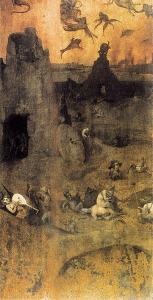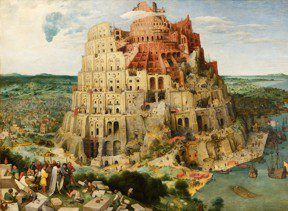 I have long felt that the most challenging passage in Scripture is found at the beginning of Genesis 6.
I have long felt that the most challenging passage in Scripture is found at the beginning of Genesis 6.
When human beings began to increase in number on the earth and daughters were born to them, the sons of God saw that the daughters of humans were beautiful, and they married any of them they chose. Then the Lord said, “My Spirit will not contend with humans forever, for they are mortal; their days will be a hundred and twenty years.”
The Nephilim were on the earth in those days—and also afterward—when the sons of God went to the daughters of humans and had children by them. They were the heroes of old, men of renown. (v. 1-4)
The most challenging, that is, to the insistence that Genesis 1-11 is intended as a narrative of past history.
Tremper Longman and John Walton admit that this is a tough passage to interpret. In his commentary on Genesis John calls it “one of the thorniest in Old Testament interpretation.” Who are the “sons of God” and why were their relationships with the daughters of humans wrong? (And as an aside, how did the Nephilim survive the flood?) Many interpretations have been advanced over the years and both Tremper and John outline some of these in their commentaries on Genesis (NIVAC: Genesis; The Story of God: Genesis). Tremper leans toward the idea that the sons of God are angels while John seems to favor the connection with heroic tyrant kings of old. Another possibility raised is that the sons of God are descendants of Seth and the daughters of humans were from the line of Cain. In The Lost World of the Flood John and Tremper suggest some connections with Mesopotamian texts and stories and admit that we simply cannot know for sure the background of this particular passage.
Frankly, if we insist that Genesis 2-11 is historical narrative giving us a snapshot of deep time (even if using rhetorical devices and figurative language as many commenters including John and Tremper agree) … this passage is a real problem. I find none of the possibilities terribly convincing. They have the feel of tortured attempts to make Scripture fit a mold we have established. John and Tremper remain committed to a historical narrative of sorts, with this passage referring to some kind of actual event. My personal opinion is that this passage is one of the clearest indications we have that Genesis 2-11 uses concepts from the ancient world to set the stage for the election of Abraham and Israel. There is important truth in Genesis 2-11, but God’s revealed truth is found in the use to which the narrator (author of Genesis) puts the stories not in any historical roots.
John and Tremper agree that the use the narrator is making of the story is of primary importance. The world is a mess. Instead of order it is characterized by increasing disorder devolving to chaos.
The Lord saw how great the wickedness of the human race had become on the earth, and that every inclination of the thoughts of the human heart was only evil all the time. The Lord regretted that he had made human beings on the earth, and his heart was deeply troubled. So the Lord said, “I will wipe from the face of the earth the human race I have created—and with them the animals, the birds and the creatures that move along the ground—for I regret that I have made them.” (v. 5-7)
The entire human experiment had failed – or so it seems. “But Noah found favor in the eyes of the Lord.” (v. 8) And in the flood we have a do-over, a restart. With chaos unleashed to clear the stage for a re-creation and re-established order.
 But destruction and re-creation did not establish order. Before we know it humans have again strayed. They start to build a tower to establish a relationship with God on their terms and to make a name for themselves. The story is ancient – it uses, John and Tremper note, appropriate technologies for something like 3250 to 2750 BC. The tower is a ziggurat – a structure in ancient Mesopotamia designed to allow the gods to come down to earth. The people are making an irreverent attempt to take control, bring God to them, and make a name for themselves.
But destruction and re-creation did not establish order. Before we know it humans have again strayed. They start to build a tower to establish a relationship with God on their terms and to make a name for themselves. The story is ancient – it uses, John and Tremper note, appropriate technologies for something like 3250 to 2750 BC. The tower is a ziggurat – a structure in ancient Mesopotamia designed to allow the gods to come down to earth. The people are making an irreverent attempt to take control, bring God to them, and make a name for themselves.
Genesis 11:1-9 gives an account of the builders taking initiative to reinitiate sacred space through the abiding presence of God in a temple (associated with the ziggurat), to bring God down, and thereby regain a privilege lost in Eden. (p. 137)
And this story is a fitting conclusion to the primordial period setting the stage for Abraham.
Tower builders conceived of sacred space as focused on themselves (making a name for themselves) – a repetition of the Garden of Eden scenario – thus forming an inclusio to Genesis 1-11. The motivation of the building project was for order determined by them and built around themselves. (pp. 137-138)
The confusion of tongues and scattering of people is a necessary prologue to election. The solution starts with Abraham and then with the people of Israel.
Genesis 11 is failed human initiative to reestablish God’s presence; Genesis 12 is God’s initiative that will lead to relationship in his presence and sacred space. (p. 139)
The stage is set.
The idea that all diversity in human language and dispersal from the Fertile Crescent occurred a mere 4000 years ago is hard to defend. There is so much evidence to the contrary. But perhaps the prologue to the flood, with the sons of God and the Nephilim, tells us that we should not consider Genesis 2-11 as historical narrative and this includes elements of the Babel story. It is pointless to worry too much about historical roots. Instead we should look for truth in the use the narrator makes of the stories. (Again, John and Tremper affirm some kind of historical root – the opinion here is my suggestion, not theirs.)
What do you make of the sons of God and the Nephilim?
What does this passage tell us about the nature of the primeval history in Genesis 2-11?
If you wish to contact me directly you may do so at rjs4mail[at]att.net
If interested you can subscribe to a full text feed of my posts at Musings on Science and Theology.















